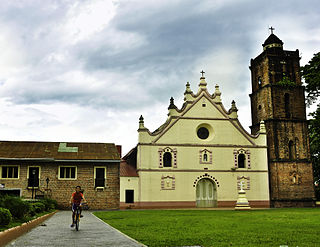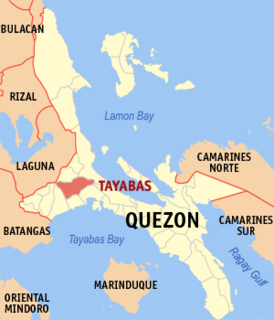 W
WAsilo de San Vicente de Paul is an orphanage located on UN Avenue in Manila, Philippines. It is run by the Daughters of Charity of Saint Vincent de Paul.
 W
WThe Ateneo de Manila University, also known simply as the Ateneo de Manila or the Ateneo and abbreviated as AdMU, is a private Catholic Jesuit research university in Quezon City, Philippines. It was founded in 1859 by the Society of Jesus, and has grown from a small publicly-funded school for the children of the Spanish colonial elite, into a nationally- and internationally-recognized teaching and research university. It is also one of several Jesuit-run educational institutions in the country bearing the Ateneo name.
 W
WAyala Bridge is a steel truss bridge over the Pasig River in Manila, Philippines. It connects the districts of Ermita and San Miguel, passing over the western tip of Isla de Convalecencia. It carries Circumferential Road 1 (C-1) and National Route 180 (N180), linking Ayala Boulevard in Ermita to P. Casal Street in San Miguel.
 W
WBagatao Island Lighthouse is a historic lighthouse located on Bagatao Island on the eastern side of the entrance to Sorsogon Bay, in the province of Sorsogon in the Philippines. The 29-ft white cylindrical iron tower is situated on the rocky headland that forms the southern point in the western end of the Island, giving the total light elevation of 135 ft. The light not only marks the entrance to the bay, but also assist ships in navigating the bend around Ticao Island of Masbate province as they head to San Bernardino Strait and exit to the Pacific Ocean.
 W
WBank of the Philippine Islands is a universal bank in the Philippines. It is the first bank in both the Philippines and Southeast Asia. It is the fourth largest bank in terms of assets, the second largest bank in terms of market capitalization, and one of the most profitable banks in the Philippines.
 W
WThe Nuestra Señora del Patrocinio de Maria Parish Church, commonly known as Boljoon Church, is a Roman Catholic Church dedicated to the Our Lady of Patrocinio in the municipality of Boljoon, Cebu, Philippines, under the Roman Catholic Archdiocese of Cebu.
 W
WThe Cabra Island Lighthouse is a historic lighthouse built on Cabra Island, the north-westernmost of the Lubang group of islands in Occidental Mindoro, Philippines. International vessels entering the Philippines from South China Sea were welcomed by the Cabra Light and directed either towards Manila Bay or the center of the archipelago through Verde Island Passage, one of busiest sea routes of the Philippines.
 W
WCape Bojeador Lighthouse, also known as Burgos Lighthouse, is a cultural heritage structure in Burgos, Ilocos Norte, that was established during the Spanish Colonial period in the Philippines. The lighthouse was first lit on March 30, 1892, and is set high on Vigia de Nagpartian Hill overlooking the scenic Cape Bojeador where early galleons used to sail by. After over 100 years, it still functions and serves ships that enter the Philippine Archipelago from the north and guide them safely away from the rocky coast of the town.
 W
WCape Engaño Lighthouse, also known as Faro de Cabo Engaño, is a historic lighthouse located at the Palaui Island in the town of Santa Ana, the province of Cagayan, Philippines. Located at the northernmost part of Luzon Island and situated atop the summit of a hill, 92 meters above sea level, the lighthouse provides a 360-degree view of Babuyan Island and the Dos Hermanas Island on the North, Pacific Ocean on the West and Engaño cove on the East.
 W
WCape Santiago Lighthouse, also known as Faro de Cabo Santiago, is a historic lighthouse located about 130 kilometres (81 mi) southwest of Manila in Barangay Bagong Silang, Calatagan, Batangas, Philippines. It is the oldest working lighthouse in Batangas and one of the oldest working lighthouses in the Philippines. It serves as a guide for ships passing through the Verde Island Passage and entering Manila Bay.
 W
WMalabrigo Point Lighthouse, also known as Faro de Punta Malabrigo, is a historic lighthouse located about 115 kilometres (71 mi) southeast of Manila in Barangay Malabrigo, Lobo, Batangas, Philippines. Completed and lit in 1896, it is one of the oldest working lighthouses in the Philippines as well as the best preserved lighthouse in the country. It serves as a guide for ships passing through the Verde Island Passage going to either Batangas Bay or Sibuyan Sea.
 W
WThe Cape Melville Lighthouse is a historic lighthouse located in the island of Balabac, the southernmost point of the province of Palawan in the Philippines. It is also the southwest corner of the archipelago. The first-order light was constructed by the Spaniards to light Balabac Strait, the treacherous body of water that separates the Philippines from the neighboring country of Malaysia.
 W
WCapones Island Lighthouse is a historic lighthouse located in Capones Island off the coast of Brgy. Pundaquit, San Antonio, in the province of Zambales, in the Philippines. The light guide international vessels coming from the north to northwest towards Subic Bay or to Corregidor Island Lighthouse at the entrance of Manila Bay. It has first-order lenses when it was first lit on August 1, 1890.
 W
WCapul Island Lighthouse is a lighthouse on Titoog Point in San Luis on the northern tip of Capul Island, Northern Samar in the Philippines. It marks the western entrance to the San Bernardino Strait coming in from Ticao Pass.
 W
WThe Colegio de San Juan de Letran (CSJL) is a private Roman Catholic Dominican institution of basic and higher learning located in Intramuros, Manila, in the Philippines. Founded in 1620, Colegio de San Juan de Letran has the distinction of being the oldest college in the Philippines and the oldest secondary institution in Asia. It is owned and administered by the friars of the Order of Preachers (Dominicans) of the Philippine Dominican Province. The school has produced Philippine presidents, revolutionary heroes, poets, legislators, members of the clergy, jurists, and it is also one of the only Philippine schools that has produced several Catholic saints who lived and studied on its campus. The school's patron saint is St. John the Baptist. The campus contains two statues, representing the two foremost alumni in the fields of secular and religious service: former Philippine President Manuel L. Quezon and Vietnamese Saint Vicente Liem de la Paz.
 W
WThe first Corregidor Island Lighthouse was a historic lighthouse located on the island of Corregidor, in the province of Cavite, Philippines. The light station was one of the most important lights in the archipelago. It was established in 1853 to guide ships to the entrance of Manila Bay on their way to the port of Manila, the most important trading center in the country. This light occupies the converging point of two lines of approach for vessels from the China Sea which steer for the entrance of the Manila Bay. Vessels from Hong Kong and the ports of China to the northwest first sight the Capones Island light off the southwest coast of Zambales. Vessels from ports of Indo-China first sight the Corregidor lights in the center. Vessels from Singapore, Indonesia, India, and all the ports of the Philippine Islands, to the south, first sight the Cabra Island light. All lines converge on Corregidor light at the bay entrance.
 W
WThe Real Fuerza de Nuestra Señora del Pilar de Zaragoza, also Fort Pilar, is a 17th-century military defense fortress built by the Spanish colonial government in Zamboanga City, Philippines. The fort, which is now a regional museum of the National Museum of the Philippines, is a major landmark of the city and symbol of its cultural heritage. Outside the eastern wall is a Marian shrine dedicated to Our Lady of the Pillar, the patroness of the city.
 W
WFort San Antonio Abad is a fortification located in the Malate district of the City of Manila built during the Spanish Colonial Period in the Philippines.
 W
WFuerte de San Pedro is a military defense structure in Cebu (Philippines), built by the Spanish under the command of Miguel López de Legazpi, first governor of the Captaincy General of the Philippines. It is located in the area now called Plaza Indepedencia, in the pier area of the city. The original fort was made of wood and built after the arrival of Legazpi and his expedition. In the early 17th century a stone fort was built to repel Muslim raiders. Today's structure dates from 1738 and is the oldest triangular bastion fort in the country. It served as the nucleus of the first Spanish settlement in the Philippines. During the Philippine Revolution at the end of the 19th century, it was attacked and taken by Filipino revolutionaries, who used it as a stronghold.
 W
WFort Santiago, built in 1593, is a citadel built by Spanish navigator and governor Miguel López de Legazpi for the new established city of Manila in the Philippines. The defense fortress is located in Intramuros, the walled city of Manila.
 W
WFuerte dela Concepcion y del Triunfo also known as Fort of Misamis is a citadel first built by Spanish Jesuit priest and commander, Jose Ducos, for the town of Misamis in Mindanao island, now the modern city of Ozamiz, Philippines. Construction of the structure completed in 1756. It is made out of coral stone and has four bastions (baluarte) namely San Fernando, San Jose, Santiago and San Ignacio. The fort was built to serve as a Spanish outpost in the area as a form of protection against marauding pirates. A special chapel was built inside the walls of the fort and an image of the Virgin of the Immaculate Conception, was enshrined in the chapel and outside the fort on the wall facing the bay, was a carved image of the Virgin Mary. The image on the Cotta's wall is believed to be miraculously growing and has been the object of pilgrimage.
 W
WHospicio de San José is a Roman Catholic welfare institution in the City of Manila, the Philippines. It is the first social welfare agency in the country, and as a foster care institution has been a home for orphans, the abandoned, special needs, and the elderly.
 W
WIntramuros is the 0.67 square kilometers (0.26 sq mi) historic walled area within the city of Manila, the capital of the Philippines. It is administered by the Intramuros Administration with the help of the city government of Manila.
 W
WThe San Isidro Labrador Parish Church, commonly known as Lazi Church, is a Roman Catholic church in the municipality of Lazi, Siquijor, Philippines within the jurisdiction of the Diocese of Dumaguete. It became an independent parish in 1857 under the advocacy of Saint Isidore the Laborer
 W
WThe San Pedro Apostol Parish Church, commonly known as Loboc Church, is a Roman Catholic church in the municipality of Loboc, Bohol, Philippines, within the jurisdiction of the Roman Catholic Diocese of Tagbilaran.
 W
WThe Nuestra Señora de la Luz Parish Church, commonly known as Loon Church, was a Roman Catholic Church in the municipality of Loon, Bohol, Philippines, under the Roman Catholic Diocese of Tagbilaran. The parish was established by the Jesuits in 1753. Father Jose Garcia commissioned Domingo de Escondrillas to design the stone church which was built from 1855 to 1864.
 W
WThe Malagonlong Bridge and is a five-span 445 ft (136 m) long stone arch bridge built during the Spanish colonial period in Tayabas, Quezon, Philippines. The bridge is known as one of the oldest bridges as well as the longest bridge made during the Spanish era. It was declared a National Cultural Treasure under the Historic Bridges of Tayabas on August 12, 2011.
 W
WThe Manila Observatory is a non-profit research institute housed on the campus of the Ateneo de Manila University in Quezon City, Philippines. It was founded by the Society of Jesus, commonly known as the Jesuits, in 1865 as the Observatorio Meteorológico del Ateneo Municipal de Manila. It was later renamed Observatorio Meteorológico de Manila. It has done weather forecasting and earthquake research and today researches seismic and geomagnetic phenomena as well as radio and solar physics.
 W
WThe San Andres Apostol Parish Church, popularly known as Masinloc Church, is an 18th-century Baroque church located at Brgy. South Poblacion, Masinloc, Zambales, Philippines. The parish church, dedicated to Saint Andrew the Apostle, is under the jurisdiction of the Roman Catholic Diocese of Iba. The church structure, a standout among Spanish-era churches in the Central Luzon region for having been built with coral stone instead of adobe stone, was declared a National Cultural Treasure by the National Museum of the Philippines along with 25 other Spanish-era churches in 2001.
 W
WMehan Garden is an open space in Manila, Philippines. It was established in 1858 by the Spanish colonial authorities as a botanical garden, called the Jardín Botánico, outside the walled city.
 W
WThe Miguel de Benavides Library, is the Central University Library of the University of Santo Tomas. The Library has been in continuous service and even antedates the existence of the University itself. Even wars did not interrupt this service and it has adapted over time.
 W
WThe Pasig River Light was the first light station in the Philippines when it was established in 1642. The first lighthouse tower in the country was erected in the station and first lit in 1846. It was then located on the north jetty at the mouth of Pasig River in San Nicolas, Manila, marking the entrance of the river for vessels cruising Manila Bay, looking to dock on the inland Port of Manila that was then located along the banks of the Pasig River in Binondo and Intramuros.
 W
WThe Philippine National Railways (PNR) is a state-owned railway company in the Philippines which operates one commuter rail service between Metro Manila and Laguna, and local services between Sipocot, Naga City and Legazpi City in the Bicol Region. It is an attached agency of the Department of Transportation.
 W
WThe Port of Iloilo in Iloilo City, Philippines, serves the province and city of Iloilo and the entire Panay Island, in Western Visayas of the Philippines. It is located away from the older port facilities on the Southern coast of Panay Island, in the Panay Gulf, and one of the country’s safest and most natural harbors. Guimaras Island shields the port from violent storms and makes it ideal for harboring ships and vessels.
 W
WThe Port of Manila refers to the collective facilities and terminals that process maritime trade function in harbors that serve the Metro Manila Area. It is located in the Port Area and Tondo area of Manila, Philippines facing the Manila Bay. It is the largest and the premier international shipping gateway to the country. The Philippine Ports Authority, a government-owned corporation, manages the Port of Manila and most of the public ports in the country. It is composed of 3 major facilities namely Manila North Harbor, Manila South Harbor and the Manila International Container Terminal.
 W
WThe Port of Subic Bay is in the Subic Bay Freeport Zone, the former U.S. Naval Base Subic Bay, on Subic Bay in the Philippines. It is one of the busiest, largest, historical and most important of ports in the Philippines. The Port is operated and managed by the Subic Bay Metropolitan Authority (SBMA).
 W
WThe Puente Colgante, originally called Puente de Clavería, was a suspension bridge that connected the Manila districts of Quiapo and Ermita across the Pasig River in the Philippines. Designed by Spanish engineer Matias Menchacatorre and completed in 1852, it was the first steel suspension bridge in Asia and the first toll bridge of its kind in the Philippines. It was replaced by Quezon Bridge in 1939.
 W
WThe Puente de España, or the Bridge of Spain, was a bridge that spanned the Pasig River in the Philippines, connecting the areas of Binondo and Santa Cruz on Calle Nueva with central Manila. The span was the oldest established in the country before it was damaged by flood in 1914. The bridge was replaced by the Jones Bridge that was started in 1916 and completed in 1921, located one block downriver from Puente de España on Calle Rosario.
 W
WThe San Raimundo de Peñafort Parish Church, commonly referred to as the Malaueg Church or Rizal Church, is an early 17th-century Baroque church located at Brgy. Poblacion, Rizal, Cagayan, Philippines. The parish church, with Saint Raymond of Peñafort as its titular patron, is under the jurisdiction of the Roman Catholic Archdiocese of Tuguegarao. The church structure has been declared a National Cultural Treasure by the National Museum of the Philippines in 2001. A marker, bearing a brief history of the church, was installed on the church's facade by the National Historical Commission of the Philippines.
 W
WSan Juan de Dios Educational Foundation, Inc. is a private, non-stock, non-profit, joint institute of education and tertiary health sciences operating as a college and a hospital in Pasay City, Philippines. Both the colleges and hospital are run by the Daughters of Charity. It started out as a hospital in 1578. The hospital is considered the oldest hospital in the Philippines. It is named after San Juan de Dios, a Portuguese-born soldier that turned health-care worker of Spain.
 W
WThe San Vicente Ferrer Parish Church, commonly referred to as Dupax Church or Dupax del Sur Church, is an 18th-century Baroque church located at Brgy. Dopaj, Dupax del Sur, Nueva Vizcaya, Philippines. The parish church, under the advocation of Saint Vincent Ferrer, is under the jurisdiction of the Roman Catholic Diocese of Bayombong. The church complex has been declared a National Cultural Treasure by the National Museum of the Philippines in July 2001.
 W
WThe Spanish colonial bridges in Tayabas are bridges built during the Spanish-colonial era in Tayabas, Quezon. The city government of Tayabas declared eleven bridges in the city as Historical bridges of Tayabas for protection purposes. These are the bridges of Alitao, Isabel II, Urbiztondo, Don Francisco de Asis, Bai, Despedidas, Ese, Princesa, Malagonlong, Lakawan and Mate. In 2011, ten bridges in Tayabas was declared as National Cultural Treasure under the Historic Bridges of Tayabas. The declared national cultural treasures under the list are the bridges of Alitao, Isabel II, Don Francisco de Asis, Gibanga, Malagonlong, Lakawan, Mate, Ese, Despedida, Tumuloy and Princesa.
 W
WThe Spanish Colonial Fortifications of the Philippines are strongholds constructed by Filipinos and Spanish under the rule of the Spaniards in the Philippines for protection against local and foreign aggressors during the Spanish Colonial Period. The fortifications were also used during the American and Japanese occupation eras. Many of the fortifications have been bady damaged, either due to old age or conflicts in the past. Currently, there has been initiatives to restore all Spanish fortifications throughout the Philippines. The initiative began when the Baluarte Luna of La Union and the Intramuros of Manila were restored in the 2010s. In 2013, a typhoon and earthquake hit Central Visayas and damaged numerous Spanish fortifications. This led to the largest restoration activity for fortifications in Philippine history.
 W
WThe San Matias Parish Church, commonly known as Tumauini Church, is a Roman Catholic church in the municipality of Tumauini, Isabela, Philippines, within the jurisdiction of the Roman Catholic Diocese of Ilagan. It became a separate parish independent from Cabagan under the advocacy of Saint Matthias in 1751.
 W
WTutuban station, also known as the Manila station or Divisoria station is the main train station of the Philippine National Railways (PNR) located in the City of Manila, Philippines.
 W
WThe University of San Carlos, also referred to by its acronym USC or colloquially shortened to San Carlos, is a private Catholic research basic and higher education institution administered by the Philippine Southern Province of the Society of the Divine Word (SVD) missionaries in Cebu City, Philippines since 1935. It offers basic education and higher education. Founded in 1783 as the Colegio-Seminario de San Carlos, it became a university in 1948.
 W
WThe Pontifical and Royal University of Santo Tomas, the Catholic University of the Philippines, or simply the University of Santo Tomas (UST), is a private, Catholic research university in Manila, Philippines. Founded on April 28, 1611, by Miguel de Benavides, Archbishop of Manila, it has the oldest extant university charter in the Philippines and in Asia, and is one of the world's largest Catholic universities in terms of enrollment found on one campus. The university is run by the Order of Preachers. UST is the only university to have been visited by three popes four times: once by Pope Paul VI on November 28, 1970, twice by Pope John Paul II on February 18, 1981, and January 13, 1995, and once by Pope Francis on January 18, 2015. The patron of the university is St. Thomas Aquinas, while St. Catherine of Alexandria is the patroness.
 W
WVigan, officially the City of Vigan, is a 4th class component city and capital of the province of Ilocos Sur, Philippines. According to the 2015 census, it has a population of 53,879 people.